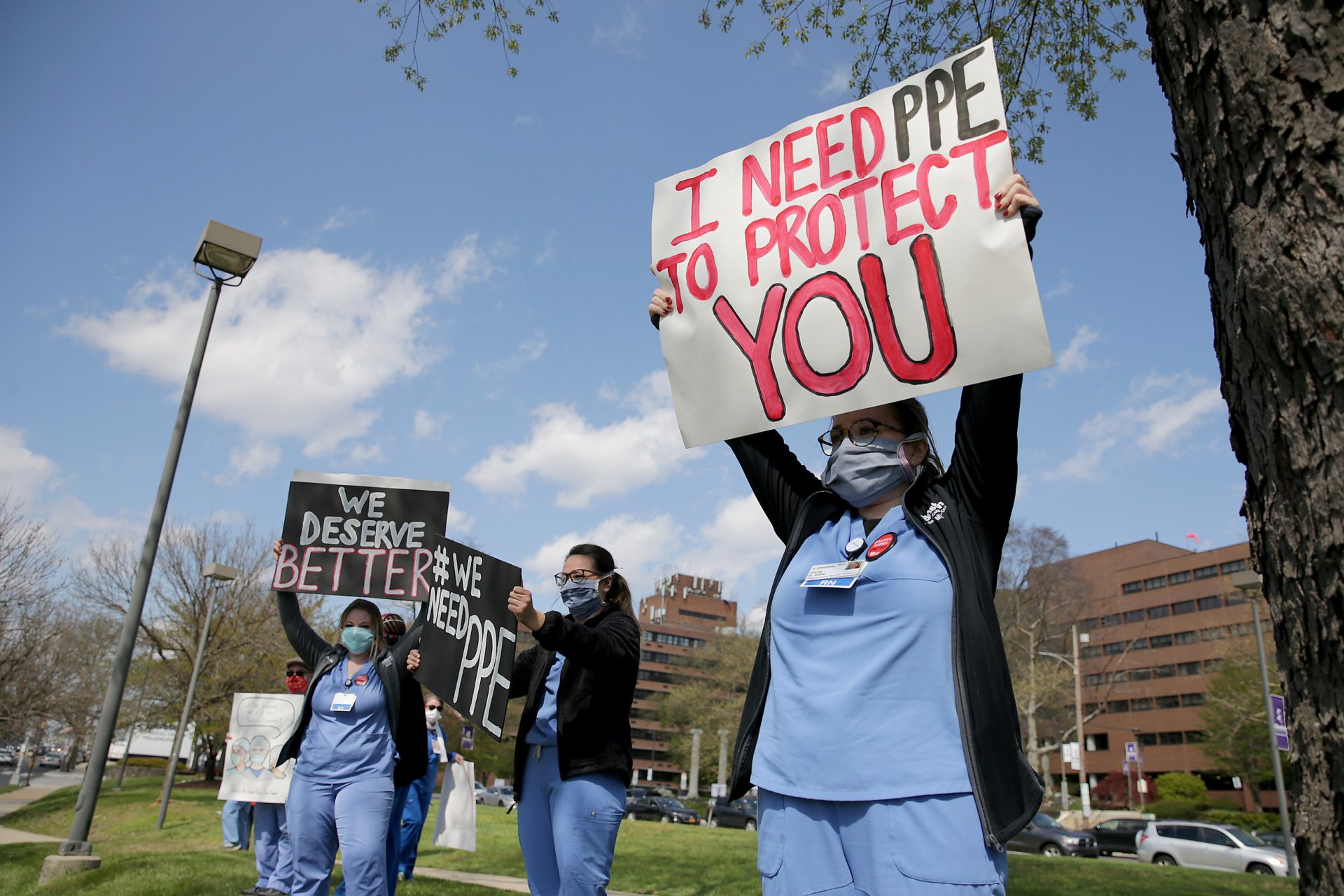
Scott Blanchard / WITF
The assistance didn’t prioritize businesses in the hardest hit parts of the state and relied on a patchwork of local economic development organizations.
Charlotte Keith/Spotlight PA
Spotlight PA is a nonpartisan, reader-funded newsroom covering Pennsylvania state government and urgent statewide issues.
HARRISBURG — In late March, Pennsylvania moved swiftly to help small businesses battered by the coronavirus outbreak, with a $61 million loan program.
Six frantic days after the program launched, the money ran out.
Businesses couldn’t apply to the state directly. Instead, they had to rely on a patchwork of local economic development nonprofits. With the loans awarded on a first-come, first-served basis, these groups were racing against time — and each other.
“All these organizations that are used to working together basically ended up competing against each other, trying to put as many applications in as possible,” said Lyle Hosler, vice president at the Economic Development Company of Lancaster County.
But a Spotlight PA review of the early results from the program, as well as interviews with more than a dozen of the nonprofits responsible for submitting applications, suggests not everyone had a fair shot at this financial lifeline.
Not all counties are equally served by these state-certified economic development groups. Some have just one, while others have several. Some are covered by larger, regional agencies. Montgomery County doesn’t have one at all.
As a result, only three of the nearly 900 applications the state received came from that county, the third largest and one of the hardest hit.
The disparities highlight the difficulty in finding a way to quickly distribute scarce but urgently needed aid to small businesses in a way that is equitable. Like the federal aid programs, the state loan program did not distinguish between businesses in different parts of the state, or give priority to those hurt the most by the crisis.
The loan program doesn’t compare in scale to federal relief efforts, which have awarded billions of dollars to Pennsylvania businesses. But it represents the state’s most significant attempt, so far, to help small businesses survive.
Further complicating the picture, some businesses that have received loans through the program are in areas now slated to begin reopening, potentially depriving businesses of relief in other parts of the state that might remain shut down for much longer.
A spokesperson for the state Department of Community and Economic Development, Casey Smith, declined to provide a breakdown of how many loan applications it received for each county. Instead, Spotlight PA surveyed 13 local economic development organizations for their totals, which the department later confirmed.
“To get the loans to small businesses as quickly as possible, we decided to utilize an existing program and use the infrastructure in place in our regions,” Smith said.
So far, more than 450 businesses have received loans. But more than a month after the program closed, hundreds of applicants are still waiting to find out if they have been approved. At least 60% of the money has been paid out, according to figures released by the state Monday.
Jordan Murray, who co-owns several Camp Bow Wow dog daycare locations in the Pittsburgh area, said the loans are “the difference between being here next year and not.” Despite being allowed to maintain some operations as an essential business, bookings have plummeted by roughly 90%, he said.
“We applied for everything we could because it was an opportunity to try and survive the crisis,” Murray said.
The loan program opened March 25, five days after Gov. Tom Wolf ordered a statewide shutdown of all but “life-sustaining” businesses. It offered low- and no-interest loans of up to $100,000 for businesses with fewer than 100 employees.
In the interest of speed, the Wolf administration repurposed an existing state loan program, streamlining the application process and cutting down on the amount of paperwork businesses would have to provide.
Another advantage for the state: The program was administered by an existing network of more than 50 local economic development groups, significantly expanding the number of people available to process applications.
These groups found themselves thrust onto the front lines of the economic devastation wrought by the pandemic. They were flooded with applications almost immediately. With only $61 million in funding available for the entire state, the money didn’t last long.
“We literally would be on calls at midnight on Saturday analyzing business tax returns to make sure we got them in,” said Joseph Boylan, executive director of Wilkes-Barre Connect.
In Bucks County, the local economic development agency was still in the process of updating its website when the program launched unexpectedly, according to Executive Director Robert Cormack.
One business owner tried to mail their application, not realizing the group’s office was closed. And, for several days, the email address for the agency listed on the state’s website was off by one letter, causing messages to bounce, Cormack said.
Local organizations were still racing to submit applications when the portal abruptly closed on the evening of March 31. Many said they received no warning from the state. Dozens of applications missed the cut-off by minutes.
By then, almost 900 applications had been submitted, seeking a total of $75 million — far more than the available funding.
A complete picture of the businesses that received loans isn’t available, because the Department of Community and Economic hasn’t finished reviewing all the applications. Nonetheless, it’s clear that some counties submitted many more than others.
Local organizations in Philadelphia and Luzerne Counties say they submitted roughly the same number of applications, 75 — even though Philadelphia’s population is almost five times bigger. Cumberland County submitted roughly the same number of applications as nearby Lancaster County, which has twice the population.
At least 50 applications were submitted on behalf of businesses in Westmoreland County. For Lehigh County, which is roughly the same size, there were 11.
Nowhere is this more starkly demonstrated than in Montgomery County, which will likely be one of the last areas to reopen. The county was at a particular disadvantage because businesses could only apply for the loans through a local economic development organization, certified by the state. But Montgomery County doesn’t have one.
The county’s former group dissolved last April, and the local redevelopment authority began taking the first steps toward becoming state certified over the summer, county officials said. That process was still underway when the state announced the loan program.
There’s no question that state officials knew about the problem: The department handling the redevelopment authority’s certification is also overseeing the loan program. But this appears to have done little to help.
“There was no time to offer feedback or express concerns in a serious way,” said David Zellers, director of the county’s commerce department.
The Department of Community and Economic Development contacted county officials to offer assistance the day after the program opened, a spokesperson said, adding that Montgomery County officials told the state they would work with other local organizations to get their applications in.
They tried, turning to organizations in neighboring counties to ask if they would submit applications on behalf of their local businesses. But the state-certified group in Berks County was overwhelmed and said it wouldn’t be able to help.
So, Montgomery County relied on the Bucks County Economic Development Corporation, sending them 59 applications. Only one was submitted before the funding ran out, said Cormack, of the Bucks organization. The group also submitted more than 20 applications for Bucks County businesses, he said.
Ultimately, only three Montgomery County businesses were able to submit loan applications. (The other two applications were from businesses that went directly to economic development organizations in other counties, local officials said.)
The county redevelopment authority didn’t finish its application to become state certified until the end of April, Executive Director John Nugent said — almost a month after the loan program closed. Thirteen state House Democrats who represent the area have written to the county commissioners, asking for a formal review.
“Given the size of Montgomery County and the economic impact of COVID-19 on local businesses, simply put, this is unacceptable,” they wrote. “It is critical that we learn what went wrong in order to ensure that our businesses are never again put at a similar disadvantage.”
A similar group of lawmakers has also asked Department of Community and Economic Development Secretary Dennis Davin to fund a second round of loans and allocate the money “based on the actual impact of the pandemic, population, and tax revenues generated for the state.”
House Democrats, including Rep. Matthew Bradford (D-Montgomery), the minority chair of the Appropriations Committee, pushed last month to replenish the program with $100 million from the state’s rainy day fund through several amendments.
The amendments failed because they were “incorrectly filed” and did not follow the chamber’s procedure for transfers from the rainy day fund, said Mike Straub, a spokesperson for the Republican majority.
Every local economic development organization contacted by Spotlight PA said that, even with the federal assistance programs, there is a desperate need for more funding to help small businesses survive.
At the Southwestern Pennsylvania Commission, in Pittsburgh, Business Finance Manager Steve Meredith began getting questions about the program even before it had been formally announced. He was still fielding inquiries about it a week after the funding ran out.
At the end of April, the state announced more businesses that had received loans through the program. But the title of the news release — “Wolf Administration Announces Second Round of State Funding for Pennsylvania Businesses” — fueled false hope that the funding had been replenished.
Meredith said he received more than 50 emails over the next few days, from business owners who had missed out on the first round and thought the program had reopened, asking if their applications could be submitted again.
So far, though, there is no sign that more help is coming any time soon.




